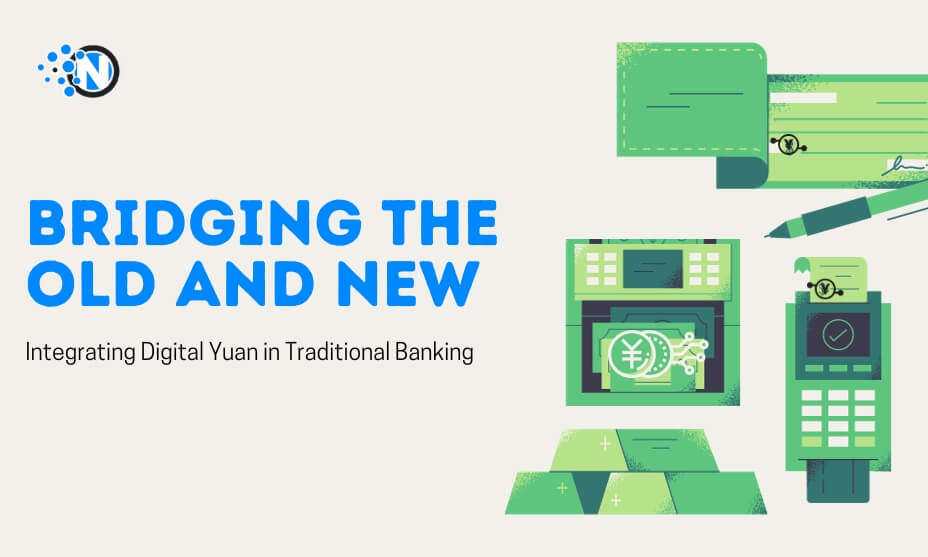Bridging the Old and New: Integrating Digital Yuan in Traditional Banking

In this modern landscape of global finance, advanced currencies have prompted central banks to venture into digital currencies. One noteworthy pioneer in this journey is China, which has made a significant stride by introducing the Digital Yuan, also called the Digital Renminbi (RMB).
This blog post will comprehensively explore integrating the Digital Yuan within the traditional banking sector. Our journey will encompass an in-depth understanding of its definition, profound impact, challenges, and far-reaching global implications. While many traditional banks are catching up with the digital revolution, platforms like yuanprofit.com already offer seamless online trading experiences for the Digital Yuan.
Understanding the Digital Yuan
What is Digital Yuan?
The Digital Yuan is the digital version of China’s official currency, the Renminbi. It is issued and regulated by the People’s Bank of China (PBOC) and operates as legal tender. Unlike cryptocurrencies like Bitcoin, the Digital Yuan is a centralized digital currency, and its value is pegged to the physical Renminbi.
Key Features and Advantages
- Security: Thanks to advanced encryption and authentication mechanisms, Digital Yuan transactions are highly secure.
- Traceability: All transactions are recorded on a blockchain, allowing for transparency and traceability.
- Offline Transactions: Unlike many digital currencies, the Digital Yuan supports offline transactions, making it accessible even in areas with limited connectivity.
- Cross-Border Use: The Digital Yuan has the potential to simplify cross-border transactions, reducing costs and processing times.
The Role of the People’s Bank of China (PBOC)
The PBOC plays a central role in the issuance and regulation of the Digital Yuan. It manages the supply of Digital Yuan, monitors transactions, and ensures compliance with regulatory frameworks. The central bank’s involvement instills trust in the digital currency and provides a degree of stability often lacking in decentralized cryptocurrencies.
Digital Yuan vs. Traditional Currency
While the Digital Yuan shares many similarities with physical Renminbi, it offers several advantages:
- Accessibility: Digital Yuan can be stored and transferred electronically, making it accessible via smartphones and other digital devices.
- Efficiency: Transactions with Digital Yuan are faster and more efficient, reducing the need for physical cash handling.
- Financial Inclusion: Digital Yuan has the potential to bring financial services to underserved populations, promoting financial inclusion.
The Evolution of Banking with Digital Yuan
Impact on Traditional Banking Infrastructure
- Integration of Digital Wallets
Traditional banks are adapting to the rise of digital currencies by integrating digital wallets into their services. Customers can securely store and manage their Digital Yuan holdings through these wallets, which often come with user-friendly interfaces and features such as budget tracking and transaction history.
- Smart Contracts and Automation
Digital Yuan transactions can be programmed with smart contracts, enabling automated execution of predefined conditions. This innovation streamlines processes such as loan approvals, reducing administrative overhead and improving efficiency.

Facilitating Cross-Border Transactions
- Simplifying International Trade
Digital Yuan holds promise for simplifying international trade. Companies can engage in cross-border transactions with reduced fees, faster settlement times, and enhanced transparency. This can promote global economic growth and cooperation.
- Reducing Foreign Exchange Risks
Currency exchange can be a costly and complex aspect of international business. The Digital Yuan’s fixed exchange rate with the physical Renminbi reduces foreign exchange risks, providing stability for businesses engaged in cross-border trade.
Regulation and Security Concerns
Regulatory Framework for Digital Yuan
The PBOC has established a comprehensive regulatory framework to govern the use of Digital Yuan. This framework includes measures to combat money laundering, verify customer identity, and protect against fraud.
- Compliance and AML Measures
Financial institutions using Digital Yuan must comply with anti-money laundering (AML) regulations and implement Know Your Customer (KYC) procedures. This ensures that the digital currency ecosystem remains secure and free from illicit activities.
Ensuring the Security of Digital Yuan
- Cybersecurity Measures
The security of Digital Yuan is a top priority. Robust cybersecurity measures are in place to protect against hacking and unauthorized access. These measures include encryption protocols, multi-factor authentication, and regular security audits.
- Privacy Concerns
While the transparency of blockchain technology is an advantage, it also raises privacy concerns. The PBOC is addressing these concerns by implementing privacy features that protect users’ sensitive data while still ensuring regulatory compliance.
Adoption Challenges and Opportunities
Acceptance by Traditional Financial Institutions
- Integration Challenges
Traditional banks face challenges when integrating Digital Yuan into their existing systems. This includes updating infrastructure, training staff, and ensuring compatibility with existing financial products.
- Competition with Private Digital Currencies
The emergence of private digital currencies, such as stablecoins, poses competition to the Digital Yuan. Traditional banks must adapt their services to remain relevant in a changing financial landscape.
Opportunities for Financial Inclusion
- Reaching the Unbanked
One of the significant advantages of the Digital Yuan is its potential to reach unbanked and underbanked populations. By providing access to digital financial services, it can empower individuals who previously lacked access to banking.
- Microtransactions and Microlending
Digital Yuan enables microtransactions, which can revolutionize industries like microlending. Small loans and transactions become economically viable, opening up new avenues for financial services.
Digital Yuan’s Global Impact
China’s Geopolitical Influence
- The Belt and Road Initiative
China’s ambitious Belt and Road Initiative, which aims to connect Asia, Europe, and Africa through infrastructure projects, can be bolstered by the Digital Yuan. It simplifies cross-border transactions, making it easier for countries along these routes to participate in trade.
- Digital Yuan as a Global Reserve Currency?
The growing internationalization of the Digital Yuan has sparked discussions about its potential as a global reserve currency. While the U.S. dollar remains dominant, the Digital Yuan’s influence is expanding, particularly in trade settlements.
Read Also: The Impact of Emerging Technologies on Accounting and Finance
Responses from Other Nations
- Digital Currency Development in Other Countries
China’s progress with the Digital Yuan has prompted other nations to explore their own central bank digital currencies (CBDCs). These digital currencies may have unique features tailored to their respective economies.
- Collaboration and Competition
International collaboration on digital currencies is on the rise. Countries are exploring partnerships and interoperability agreements to ensure the smooth flow of digital currencies across borders. However, competition for influence in the digital currency space is intensifying.
Conclusion
The integration of Digital Yuan in traditional banking represents a significant step in the evolution of finance. It offers advantages in terms of security, efficiency, and financial inclusion, while posing regulation and competition challenges. The financial industry is at the cusp of a profound transformation as the world watches China’s experiment with the Digital Yuan. Preparing for this future is imperative for traditional banks and financial institutions looking to remain relevant in the digital age. The Digital Yuan is not merely a new form of currency; it is a catalyst for change that bridges the old and the new in banking.




